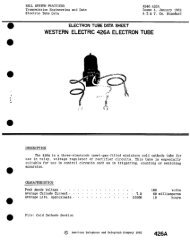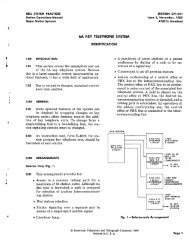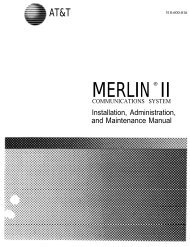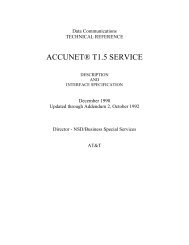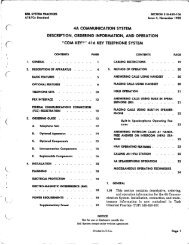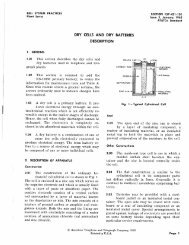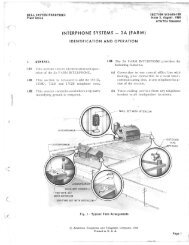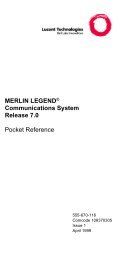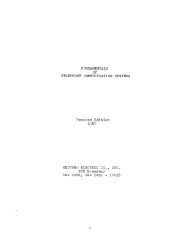COMMON LANGUAGE LOCATION IDENTIFICATION (CLLI) CODE ...
COMMON LANGUAGE LOCATION IDENTIFICATION (CLLI) CODE ...
COMMON LANGUAGE LOCATION IDENTIFICATION (CLLI) CODE ...
You also want an ePaper? Increase the reach of your titles
YUMPU automatically turns print PDFs into web optimized ePapers that Google loves.
1.04 This Section has been structured to permit<br />
extraction of Part 10, <strong>CLLI</strong> Exhibits, for use<br />
as an encoding aid.<br />
1.05 Common Language Location Identification<br />
codes are in widespread use throughout the<br />
Bell System and are maintained in an on-line master<br />
data base by the Bell Laboratories Common Lan<br />
guage Department at Piscataway, New Jersey. Each<br />
Operating Company's <strong>CLLI</strong> coordinator is responsible<br />
for maintaining that Company's <strong>CLLI</strong> database,<br />
using procedures defined in this section and in the<br />
<strong>CLLI</strong> On-line System User's Manual. Descriptive information<br />
associated with the <strong>CLLI</strong> code, may be<br />
found in the <strong>CLLI</strong> On-Line System.<br />
1.06 Common Language Location Identification<br />
codes identify originating and terminating<br />
locations for Common Language Facility Identification<br />
(CLFI) and for Common Language Circuit Identification-Message<br />
Trunks (CLCI-MSG). Refer to<br />
Section 795-450-100 and Section 795-400-100, respectively,<br />
for descriptions of these uses of <strong>CLLI</strong>. The<br />
<strong>CLLI</strong> codes have been deployed extensively in cen<br />
trally developed systems, eg, TIRKS, FACS, etc. For<br />
these reasons, indiscriminate and/ or unnecessary<br />
<strong>CLLI</strong> code changes should be avoided.<br />
1.07 It is important to remember that <strong>CLLI</strong> codes<br />
should be without specific user orientation, ie,<br />
codes should not be oriented toward a particular de<br />
partment or user and should be within the guidelines<br />
of this section.<br />
1.08 All Operating Company personnel having re<br />
sponsibility for assigning and maintaining<br />
<strong>CLLI</strong> codes must know what codes are stored in their<br />
portion of the <strong>CLLI</strong> master file.<br />
It is not the intent of the <strong>CLLI</strong> codes to identify all<br />
information pertaining to the location or to identify<br />
each piece of equipment or each work group at a particular<br />
location. For most of the detail, the user must<br />
look beyond <strong>CLLI</strong> to other code sets or data bases.<br />
1.09 Questions concerning codes contained in this<br />
section, and requests for new codes should be<br />
directed, via the Operating Company Common Language<br />
Coordinator, to the Common Language De<br />
partment at Bell Laboratories. Development of new<br />
codes and changes in coding procedures require approval<br />
of AT&T Company.<br />
ISS 5, SECTION 795-1 00-1 00<br />
2. <strong>CODE</strong> DESCRIPTION AND STRUCTURE<br />
A. Code Description<br />
2.01 The Common Language Location Identifica-<br />
tion code is a geographic identifier which<br />
uniquely identifies the geographic location of places<br />
and certain "things" of interest to the Bell System<br />
and Operating Telephone Companies in the United<br />
States, Canada, and other countries. Collectively,<br />
these are known as "<strong>CLLI</strong>" or "location" codes, and<br />
are used in various manual and mechanized systems.<br />
2.02 The <strong>CLLI</strong> codes identify existing and pro-<br />
posed buildings which contain or will con<br />
tain personnel and/or equipment, eg, switching<br />
machines, boards/ desks, radio and carrier equipment,<br />
plant service centers, testrooms, frames, maintenance<br />
groups, etc. They identify nonbuilding<br />
locations of entities, such as repeaters, poles, manholes,<br />
facility junctions, etc. In addition, <strong>CLLI</strong> codes<br />
identify certain customer locations.<br />
B. Code Structure<br />
2.03 The <strong>CLLI</strong> code is an 11-character mnemonic<br />
alphanumeric code consisting of the following<br />
elements:<br />
(a) Place (character positions 1 through 4).<br />
(b) State of the United States, Province or Territory<br />
of Canada, or Country (character positions<br />
5 and 6). These are known collectively as<br />
"State" codes.<br />
(c) Building (character positions 7 and 8).<br />
(d) Entity (character positions 9 through 11),<br />
formerly called Building Subdivision. All<br />
Traffic, Plant, and Administrative Units have<br />
been regrouped into two categories: Switching<br />
Entities and Nonswitching Entities.<br />
(e) Nonbuilding location or customer loca<br />
tion (character positions 7 through 11).<br />
2.04 These elements may be combined into the fol<br />
lowing basic Common Language Location<br />
Identification formats:<br />
(a) Place, state, building, and entity (11 characters)<br />
(b) Place, state, and nonbuilding location (11<br />
characters)<br />
Page 3







